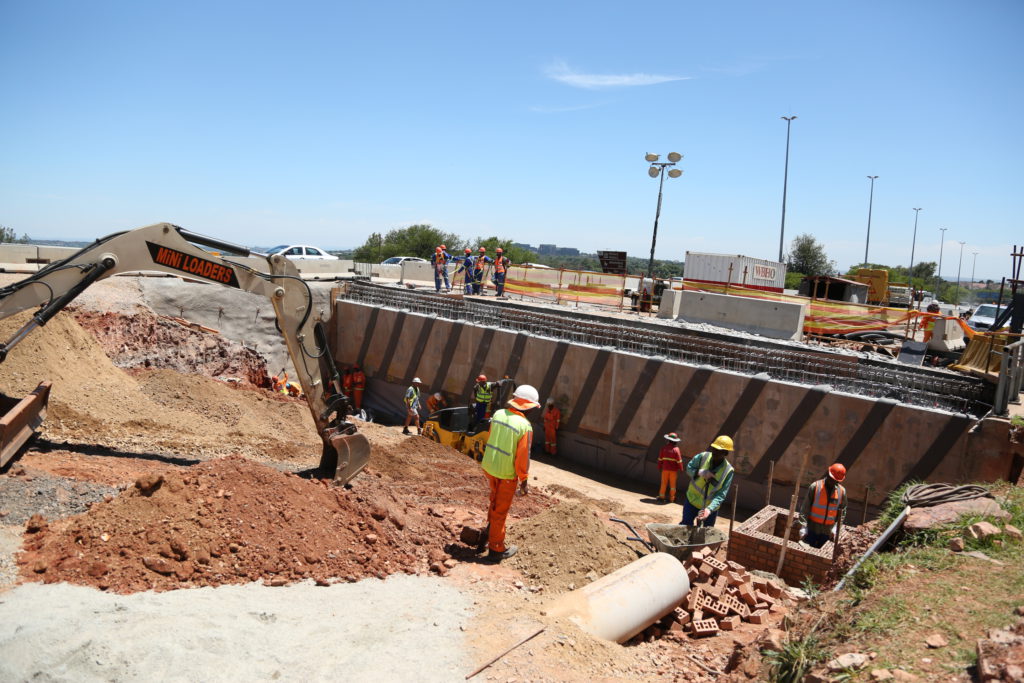
Work underway on the M1 Federation Bridge
Dr Sean Phillips, Managing Director of the Johannesburg Roads Agency explains that the Oxford and Federation bridges project, initially anticipated for completion in February 2017 will now be extended to September 2017. Improvements to the Double Decker section were originally envisaged to be completed by May 2017 but it is now anticipated that they will be completed by the end of 2017.
Oxford and Federation bridges
The causes of the delays on the Oxford and Federation bridges project have been sporadic labour unrest and unforeseen geotechnical complications.
The labour unrest occurred in between April and August and resulted in a loss of approximately six weeks. The geotechnical complications have resulted in an extension of the scope of the works, which accounts for the remainder of the extended construction period.
On a site visit, consulting engineer David Smith from WBHO explained that the state of the existing fill was not as good as originally anticipated and much of it has to be replaced. The fill under the Federation Bridge had cracked because of inflow of water due to poor drainage and had to be repaired. Additional drainage has now been put in place.
Much more significant geotechnical problems were experienced at the Oxford Road Bridge. The road has experienced a great deal of movement and part of the road had begun to sink as a result of this movement and poor material below ground. Left unattended this could have become a safety issue.
The bridge is located on a fault between quartzite and granite which poses a challenge. In addition to this, water had begun to penetrate into the layer works of the road due to improper drainage. As a result, this material had to be dug up and replaced with good road building material.
The biggest challenge is to secure the foundations, which is the main cause of the delay. In some places the contractor has drilled as deep as 35 m without encountering any solid bedrock. “There is just wet mud,” said Smith. The initial contract had only called for treatment to a depth of 10 m.
In order to secure the bridge structure WBHO is using a process called jet grouting. This involves drilling a small hole through the footing of the concrete and pumping it with grout at 400 bars of pressure. This works to create a column below the concrete footing, creating a solid base to stabilise the structure. Stabilisation is being done from 13 m to 25 m below the surface.
Double Decker Bridge
The delays in the Double Decker project have been caused by financial difficulties experienced by the contractor which resulted in the work stopping for a period of approximately four months. This has now been resolved and the contractor is back on site and work is again progressing well.
The extension of the Oxford and Federation bridges project means that the M1 between Killarney bend and St Andrews will remain with a limited number of lanes open for a longer period than previously announced.
On the Double Decker section of the M1 – between Carr and Anderson streets in the city centre – the work includes rehabilitation and structural repairs, asphalt surfacing, expansion joints, drainage systems and new road signs. The Federation and Oxford bridges are also undergoing major facelifts. A 2 km section of M1 freeway between Rockridge and Federation Roads is being rehabilitated and the existing storm water drainage system in the area replaced.
On the Double Decker most of the work is being done at night to avoid disruption of traffic.
Traffic considerations
“Joburg road users have adapted exceptionally well to the traffic restrictions with temporary lane and road closures,” says MMC for Transport Cllr Nonhlanhla Makhuba. “We thank the public for their positive spirit, for their courteous and patient driving and for heeding the JRA’s call to make use of public transport as well as alternative routes to travel between destinations in the City,” she says.
The M1 project has seen a reduction in traffic since the major works have intensified. The latest traffic volumes indicate that congestion is far less than originally projected. “Traffic volumes indicate that motorists have adjusted their travelling times as morning and evening peak hours start much earlier now, and also the traffic volumes have significantly decreased. This reflects a shift in travelling patterns, the use of alternative routes as well as the use of public transport.”
Dr Phillips calls on Joburg road users to familiarise themselves with the lane reductions, to plan their journeys in advance and to consider alternative routes.
The City’s Rea Vaya Bus Rapid Transit system, Metrobus, Metrorail, Gautrain as well as Taxi’s offers public transport options for commuters and traffic applications will provide alerts on possible traffic jams and delays.
Dr Phillips says the section of the freeway is a key arterial route through the heart of Johannesburg. “We are proud to lead this road infrastructure investment of the City that carries some 80 000 private cars, commercial traffic and public transport – such as buses and taxis – all vital to the growth of southern Africa’s most important economic hub. We are confident that JRA’s rehabilitation work will contribute to the quality of life of residents and the safety of all commuters who use our road network for many years to come.”
Upcoming traffic changes
During the next phase of construction the following traffic changes will be made:
- From 21 November 2016 to 15 December 2016, Oxford road onramp onto the M1 Southbound will be closed
- From March 2017 to September 2017 Oxford road offramp from the M1 travelling Northbound will be closed. Furthermore, all M1 traffic between Killarney and St Andrews will be diverted to the southbound carriage way with 2 lanes open to traffic in both directions and separated by a concrete barrier
- From 30 November 2016 to 15 January 2017 Henry Nxumalo will have one lane temporarily reduced to accommodate rehabilitation on the Double Decker bridges
- From 22 January 2017 to 12 February 2107 the Double Decker bridge will be reduced by one lane on both carriageways
- Certain lanes on the Double Decker section as well as the M1 section between Killarney and St Andrews can be closed during off peak times at night and over weekends to accommodate construction work









